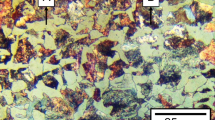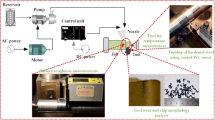Abstract
The paper presents an original study of the influence of extreme pressure and anti-wear (EP/AW) additives on the surface topography of double-phase steel during turning with different cooling media and variable flow rates. The obtained surface topographies were compared using frequency and fractal analyses for dry, minimum quantity cooling lubrication (MQCL), and MQCL + EP/AW methods. Results showed that the addition of phosphate ester-based additives to an active medium caused the formation of tribofilm on the tool-chip interface and thus a change in the lubricating properties by reducing friction. The tool wear and the formation of the thin-layered tribofilm were also incorporated. The application of the MQCL method with the EP/AW additives led to a decrease in particular surface topography parameters from 8 % to 38 % in comparison with the effects of dry cutting and from 6 % to 35 % in comparison with the effects of machining under MQCL conditions. An exception was the result obtained for the surface roughness height parameter Sp, which was higher than that obtained after the MQCL + EP/AW process for the lowest investigated feed per revolution f = 0.1 mm/rev. This observation was correlated with the uneven formation of the tribofilm on the machined surface. The phosphate ester-based additive used in the MQCL + EP/AW method contributed to achieving tool wear that was less than that obtained by the processes conducted under dry and MQCL conditions.
Similar content being viewed by others
References
W. Zębala, B. Słodki and G. Struzikiewicz, Productivity and reliability improvement in turning Inconel 718 alloy - case study, Eksploatacja i Niezawodność - Maintenance and Reliability, 15 (4) (2013) 421–426.
A. Glowacz, W. Glowacz, Z. Glowacz and J. Kozik, Early fault diagnosis of bearing and stator faults of the singlephase induction motor using acoustic signals, Measurement, 113 (2018) 1–9.
S. Chinchanikar and S. K. Choudhury, Hard turning using HiPIMS-coated carbide tools: Wear behavior under dry and minimum quantity lubrication (MQL), Measurement, 55 (2014) 536–548.
N. R. Dhar, M. Kamruzzaman and M. Ahmed, Effect of minimum quantity lubrication (MQL) on tool wear and surface roughness in turning AISI-4340 steel, J. Mater. Process Technol., 172 (2) (2006) 299–304.
M. Emami, M. H. Sadeghi, A. A. D. Sarhan and F. Hasani, Investigating the minimum quantity lubrication in grinding of Al2O3 engineering ceramic, J. of Cleaner Production, 66 (2014) 632–643.
A. Shokrani, V. Dhokia and S. T. Newman, Environmentally conscious machining of difficult-to-machine materials with regard to cutting fluids, International J. of Machine Tools and Manufacture, 57 (2012) 83–101.
A. Górny, Man as internal customer for working environment improvements, Procedia Manufacturing, 3 (2015) 4700–4707.
I. Gabryelewicz, J. Sadłowska-Wrzesińska and E. Kowal, Evaluation of safety climate level in a production facility, Procedia Manufacturing, 3 (2015) 5822–5829.
I. Gabryelewicz, P. Krupa and J. Sadłowska-Wrzesińska, Online measurement of work safety culture - statement of research, MATEC Web Conferences, 94 (2017) 1–10.
F. Pusavec, D. Kramar, P. Krajnik and J. Kopac, Transitioning to sustainable production - Part II: Evaluation of sustainable machining technologies, J. of Cleaner Production, 18 (12) (2010) 1211–1221.
R. W. Maruda, S. Legutko, G. M. Krolczyk and P. Raos, Influence of cooling conditions on the machining process under MQCL and MQL conditions, Tehnički Vjesnik-Technical Gazette, 22 (4) (2015) 965–970.
R. R. Chakule, S. S. Chaudhari and P. S. Talmale, Evaluation of the effects of machining parameters on MQL based surface grinding process using response surface methodology, J. Mech. Sci. Technol., 31 (8) (2017) 3907–3916.
G. M. Krolczyk, P. Nieslony, R. W. Maruda and S. Wojciechowski, Dry cutting effect in turning of a duplex stainless steel as a key factor in clean production, J. of Cleaner Production, 142 (2017) 3343–3354.
W. Zębala and R. Kowalczyk, Estimating the effect of cutting data on surface roughness and cutting force during WC-Co turning with PCD tool using Taguchi design and ANOVA analysis, International J. Advanced Manufacturing Technology, 77 (9) (2015) 2241–2256.
P. N. L. Pavani, R. P. Rao and S. Srikiran, Performance evaluation and optimization of nano boric acid powder weight percentage mixed with vegetable oil using the Taguchi approach, J. Mech. Sci. Technol., 29 (11) (2015) 4877–4883.
Y. Shokoohi, E. Khosrojerdi and B. H. Rassolian Shiadhi, Machining and ecological effects of a new developed cutting fluid in combination with different cooling techniques on turning operation, J. of Cleaner Production, 94 (2015) 330–339.
A. K. Rozentsvaig and C. S. Strashinskii, Modeling of heat transfer conditions in cooling lubricant emulsions with lowboiling continuous media in narrow gaps, Int. J. of Heat and Mass Transfer, 102 (2016) 555–560.
S. Zhang, J. F. Li and Y. W. Wang, Tool life and cutting forces in end milling Inconel 718 under dry and minimum quantity cooling lubrication cutting conditions, J. of Cleaner Production, 32 (2012) 81–87.
R. W. Maruda, G. M. Krolczyk, E. Feldshtein, P. Nieslony, B. Tyliszczak and F. Pusavec, Tool wear characterizations in finish turning of AISI 1045 carbon steel for MQCL conditions, Wear, 372-373 (2017) 54–67.
K. Park, J. Olortegui-Yume, M. C. Yoon and P. Kwon, A study on droplets and their distribution for minimum quantity lubrication (MQL), International J. of Machine Tools and Manufacture, 50 (9) (2010) 824–833.
A. Duchosal, S. Werda, R. Serra, C. Courbon and R. Leroy, Experimental method to analyze the oil mist impingement over an insert used in MQL milling process, Measurement, 86 (2016) 283–292.
T. Leppert, Effect of cooling and lubrication conditions on surface topography and turning process of C45 steel, International J. of Machine Tools and Manufacture, 51 (2) (2011) 120–126.
P. C. Priarone, M. Robiglio, L. Settineri and V. Tebaldo, Effectiveness of minimizing cutting fluid use when turning difficult-to-cut alloys, Procedia CIRP, 29 (2015) 341–346.
R. W. Maruda, G. M. Krolczyk, P. Nieslony, S. Wojciechowski, M. Michalski and S. Legutko, The influence of the cooling conditions on the cutting tool wear and the chip formation mechanism, J. Manuf. Process., 24 (2016) 107–115.
N. R. Dhar, M. W. Islam, S. Islam and M. A. H. Mithu, The influence of minimum quantity of lubrication (MQL) on cutting temperature, chip and dimensional accuracy in turning AISI-1040 steel, J. Mater. Process Technol., 171 (1) (2006) 93–99.
E. A. Rahim, M. R. Ibrahim, A. A. Rahim, S. Aziz and Z. Mohid, Experimental investigation of minimum quantity lubrication (MQL) as a sustainable cooling technique, Procedia CIRP, 26 (2015) 351–354.
M. Niemczewska-Wójcik, Multi-sensor measurements of titanium alloy surface texture formed at subsequent operations of precision machining process, Measurement, 96 (2016) 8–17.
G. M. Krolczyk, R. W. Maruda, P. Nieslony and M. Wieczorowski, Surface morphology analysis of duplex stainless steel (DSS) in clean production using the power spectral density, Measurement, 94 (2016) 464–470.
R. W. Maruda, S. Legutko, G. M. Krolczyk, S. Hloch and M. Michalski, An influence of active additives on the formation of selected indicators of the condition of the X10CrNi18-8 stainless steel surface layer in MQCL conditions, Int. J. Surf. Sci. Eng., 9 (5) (2015) 452–465.
D. Setti, M. K. Sinha, S. Ghosh and P. V. Rao, Performance evaluation of Ti-6Al-4V grinding using chip formation and coefficient of friction under the influence of nanofluids, International J. of Machine Tools and Manufacture, 88 (2015) 237–248.
R. W. Maruda, E. Feldshtein, S. Legutko and G. M. Krolczyk, Analysis of contact phenomena and heat exchange in the cutting zone under minimum quantity cooling lubrication conditions, Arab. J. Sci. Eng., 41 (2) (2016) 661–668.
R. W. Maruda, E. Feldshtein, S. Legutko and G. M. Krolczyk, Research emulsion mist generation in the conditions of minimum quantity cooling lubrication (MQCL), Tehnički Vjesnik-Technical Gazette, 22 (5) (2015) 1213–1218.
P. Nieslony, G. M. Krolczyk, S. Wojciechowski, R. Chudy, K. Zak and R. W. Maruda, Surface quality and topographic inspection of variable compliance part after precise turning, Appl. Surf. Sci., 434 (2018) 91–101.
J. M. Vieira, A. R. Machado and E. O. Ezugwu, Performance of cutting fluids during face milling of steels, J. Mater. Process Technol., 116 (2-3) (2001) 244–251.
M. J. Hadad, T. Tawakoli, M. H. Sadeghi and B. Sadeghi, Temperature and energy partition in minimum quantity lubrication-MQL grinding process, International J. of Machine Tools and Manufacture, 54-55 (2012) 10–17.
R. Maruda and E. Feldshtein, The analyze of cutting force and heat sink changes when turning of C45 steel in MQCL conditions on the base of computer modeling, International J. of Applied Mechanics and Engineering, 15 (4) (2010) 1037–1045.
S. Wojciechowski, R. W. Maruda, G. M. Krolczyk and P. Nieslony, Application of signal to noise ratio and grey relational analysis to minimize forces and vibrations during precise ball end milling, Precision Engineering, 51 (2018) 582–596.
Author information
Authors and Affiliations
Corresponding author
Additional information
Recommended by Associate Editor Sang-Hee Yoon
Radoslaw Maruda graduated from the Technical University of Zielona Góra. He has been working at the Faculty of Mechanical Engineering, University of Zielona Góra since his graduation. His current research focuses on the ecological cooling (MQL and MQCL methods) of cutting zones.
Grzegorz Krolczyk is a Professor at the Opole University of Technology (OUTech). He is an Originator and Project Manager of the new Surface Integrity Laboratory of OUTech. He is author and coauthor of 136 scientific publications (62 JCR papers) and nearly 29 studies and industrial applications. His main scientific directions are analysis and improvement of manufacturing processes.
Szymon Wojciechowski graduated from the Poznan University of Technology. He works at the Faculty of Mechanical Engineering and Management, Poznan University of Technology. His scientific interests concentrate on modeling and investigating forces in the curvilinear milling of hard-to-machine materials.
Krzysztof Zak obtained his Ph.D. in 2008 in mechanical engineering from OUTech. He is currently an Assistant Professor in the Department of Manufacturing Engineering and Production Automation. He is author and coauthor of many articles published in reputable journals. He specializes in machining and surface engineering.
Witold Habrat received his Ph.D. from the Rzeszow University of Technology in 2006. He works at the Faculty of Mechanical Engineering and Aeronautics in this university. His research interests include modeling of machining of difficult- to-cut materials, high-pressure cooling, laser-assisted machining, optimization of machining processes, and analysis of surface layer states.
Piotr Nieslony is a Professor at OUTech and the Head of the Department of Manufacturing Engineering and Production Automation at the Faculty of Mechanical Engineering. His research fields include finite element analysis of machining processes, tribology, analysis of tool wear, tool coatings, optimization procedures of technological processes, and surface structure analysis.
Rights and permissions
About this article
Cite this article
Maruda, R.W., Krolczyk, G.M., Wojciechowski, S. et al. Effects of extreme pressure and anti-wear additives on surface topography and tool wear during MQCL turning of AISI 1045 steel. J Mech Sci Technol 32, 1585–1591 (2018). https://doi.org/10.1007/s12206-018-0313-7
Received:
Revised:
Accepted:
Published:
Issue Date:
DOI: https://doi.org/10.1007/s12206-018-0313-7




